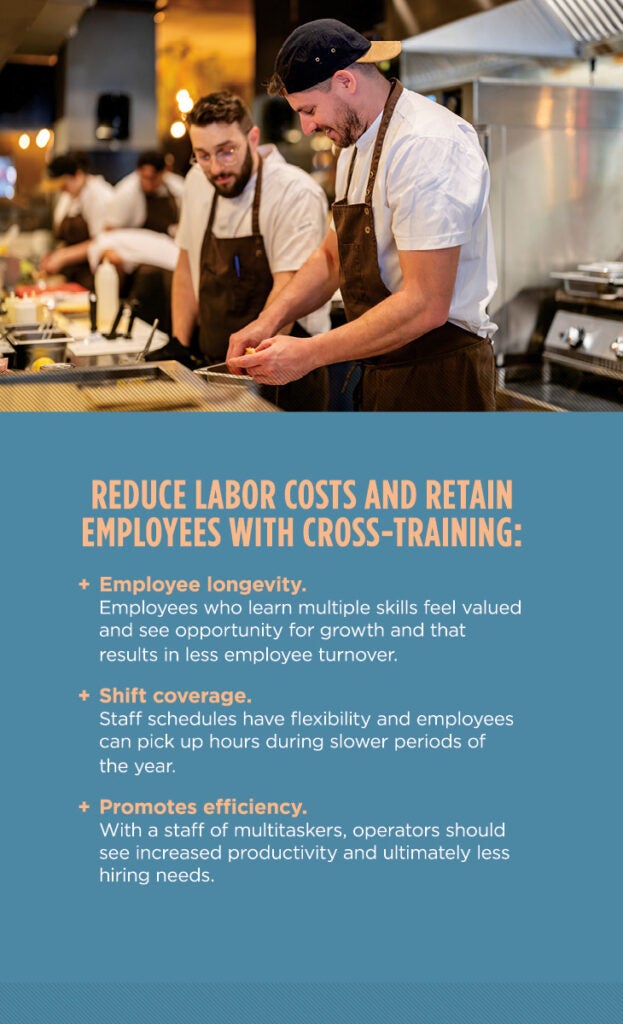The line between back and front of house for many industry operators has become blurred as the need for cross-training employees has become crucial for survival.
It’s no secret that the food service continues to struggle as operators attempt to come back from a devastating two years following the pandemic.
It’s estimated that 3.5 million U.S. workers have left the industry since the start of the pandemic in March 2020, said Gordon Food Service® Business Solutions Specialist Carolyn Corcoran, based in Allegheny Valley.
But for those who have stayed, the benefits of cross-training help them as much as it does the overall operation.
“You have a level of security within your job. You have the extra hours and it’s guaranteed income. Everybody wins with having cross-training available,” she said. “Staff learns secondary positions. They learn to move with the flow of service and that elevates the stress from staff.”
The concept isn’t exactly new to the industry, but it’s becoming more common and essential for many operators to remain open.
“You learn to do the job of two people,” she said. “You learn more about the industry and you’re more invested in the company.”
Teach Them and They Will Stay
Gordon Food Service® Culinary Specialist Heidi Kise, based in the Chicago area, said there is little downside for an employee to be cross-trained.
“Knowledge is power and gives people the opportunity to grow in the organization,” she said. “It just takes a boss or one owner to give them a chance.”
Corcoran said operators need to lay out the perks of learning a new skill before throwing them into something.
“I know it’s easier said than done, but explain to staff why it benefits them. That’s how you get them on board. When you really believe in it, they will believe in it.
Here’s what Corcoran suggests:
- Be clear: Write out skills needed to be a shift lead, for example, coupled with any additional responsibilities that may be asked of them.
- Reward: Offer a raise once the employee masters the additional tasks required of them.
- Be specific: “You don’t want to cross-train someone too many times. Then they’re a generalist. You want to stay as specialized as possible, doing an above-average job,” Corcoran said.
Fear of Change Halts Implementation
Gordon Food Service® Business Solutions Specialist Laura Taningco, based in Ohio, said some are reluctant to cross-train.
“I have operators trying to figure out labor issues, but I haven’t had anyone pull the trigger,” she said. “It is a fear of change and there is a lot of reluctance to reorganize staff into a non-traditional model.”
But Taningco said, if operators embrace change, they will have a “better labor pool to pull from” when there are gaps in shift coverage.
“I tell operators that sometimes we have to slow down to speed up. We have to understand and address the root causes of why we are so busy,” she said. “Operators need to find or intentionally make time to work on their business with working less time in their business as a result.”
The other obstacle operators are facing is that front-of-house employees worry their wages will be affected if they work shifts in the back of house.
“It becomes a conversation of how do you get your staff to understand why we should make this change and why would (the employee) want to be cross-trained, Taningco said. “Basically operators need to spell out, ‘Here’s what’s in it for you.’”
Leveling the Playing Field: Step No. 1 in Cross-Training Implementation
Some operators have turned to paying all staff a fair hourly wage and then splitting tips with front and back of house. Once that happens, and if the “why” and “what’s in it for me” are accepted, the reluctance on the part of the front-of-house staff dissipates.
“That is where I see staff embracing the cross-training opportunity. An hourly wage provides a steady income, no matter the guest traffic for front-of-house, more hours are available to work with cross-trained positions, and the back-of-house finally has the opportunity to earn more wages via the tip share as well as learn a new position elsewhere in the restaurant.
Once the employees learn more than one skill and take on more responsibility, it’s a win-win for operators and the employee, Taningco said.
“It’s a real opportunity to gain development as well as marketability for future roles in the current operation or in another establishment,” she said.
Read more from Foodscape












